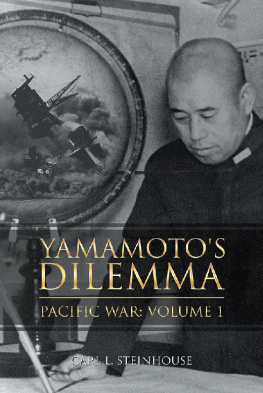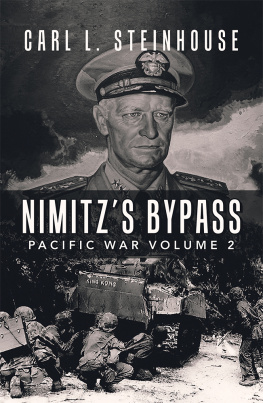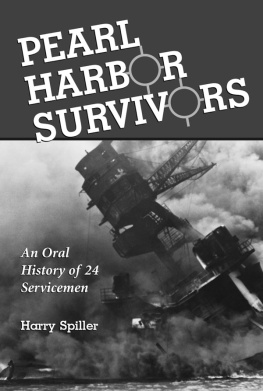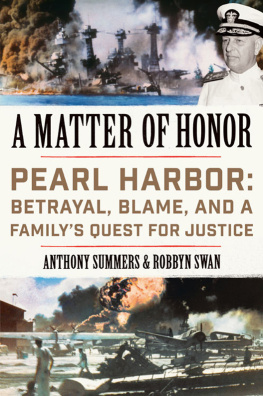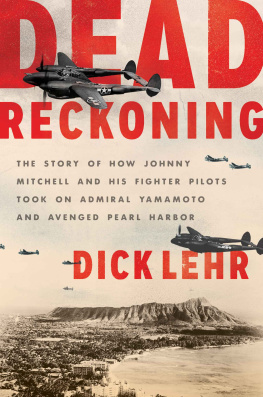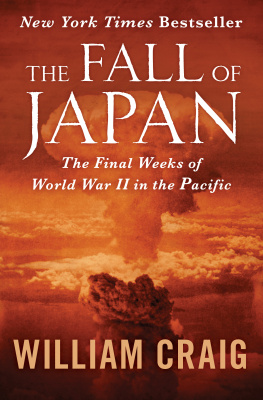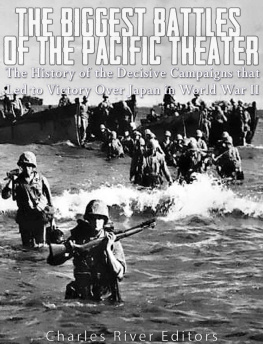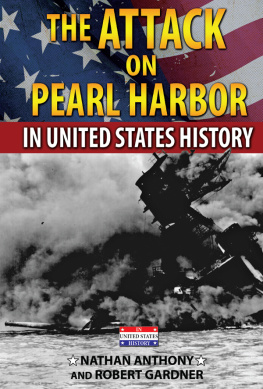YAMAMOTO'S DILEMMA
PACIFIC WAR: VOLUME 1

This Japanese Admiral planned the attack on Pearl Harbor but warned Japan could not win the war. They did not listen to him. And American Admiral Nimitz saw to it that they did not win!
CARL L. STEINHOUSE

AuthorHouse
1663 Liberty Drive
Bloomington, IN 47403
www.authorhouse.com
Phone: 1 (800) 839-8640
2020 Carl L. Steinhouse. All rights reserved.
No part of this book may be reproduced, stored in a retrieval system, or transmitted by any means without the written permission of the author.
Published by AuthorHouse 12/10/2019
ISBN: 978-1-7283-3908-5 (sc)
ISBN: 978-1-7283-3907-8 (e)
Library of Congress Control Number: 2019920175
Any people depicted in stock imagery provided by Getty Images are models,
and such images are being used for illustrative purposes only.
Certain stock imagery Getty Images.
Because of the dynamic nature of the Internet, any web addresses or links contained in this book may have changed since publication and may no longer be valid. The views expressed in this work are solely those of the author and do not necessarily reflect the views of the publisher, and the publisher hereby disclaims any responsibility for them.
Contents
In Japan, personal names take the form of family name first, followed by the given name. To avoid confusion, the author adopts the Western/American form of given name first and family following. In Japan, friends address each other generally by their family name. That is the custom and not a sign of disrespect or impoliteness, and I follow that custom in this book.
This book, Volume I, takes us up to the time of the death of Admiral Yamamoto. Volume II, if I survive old age, will take us to the end of the war. Volume II, partially researched, has yet to be put down on paper with pen (or more accurately, into a digital file by computer key board).
Carl L. Steinhouse
2018
Japanese idiom: Hakko Ichiu:
The world under one Japanese Imperial roof.
American idiom, probably from the Old West:
Dont bite off more than you can chew, buster.
Konoye spread his arms sending Yamamoto a silent What can I do? sign. The prime minister sighed. Admiral, Tojo and Nagano are hell-bent for war and Ive tried, but there seems little I can do to stop them. The emperor seems inclined to give them their head. Tell me, what do you think our chances are in a war with America?
Yamamoto frowned. Ive been asked the question regarding Pearl Harbor often and my answer is always the same, prime minister-san. If we follow my plan to surprise bomb and torpedo the American Fleet and facilities at Pearl Harbor, well set them back for a whileno doubt about itand well be successful for six months, and maybe a year or even a little longer. But after that I cannot guarantee, as their industrial might gears up and their large population is called up to serve in the military. Then, prime minister, I think we will be in trouble.
The word samurai means those who serve and in old Japan, most samurai held their land for a more senior overlord to whom they owed military service and allegiance. The samurai learned the art of sword fighting at an early age. When the country became united in the late 15 th century, the samurai came out on top; they were the only ones permitted to carry a sword and were paid in rice by their feudal lords. The samurais sword, called a katana, was a master-crafted blade, very strong, sharp, and durable. This sword was usually accompanied by a shorter sword, a wakizashi , whose blade was crafted equally fine. The samurai, expected to be brave, tough-willed individuals, were skilled swordsman and riders, fiercely loyal to their lord, and willing to face death at any moment. Indeed, their moral code stressed frugality, loyalty, martial arts, and honor unto d eath.
In the civil war of 1868, also known as the Bosshin War, the Imperial forces defeated the samurai of Nagaoka and one clan on the losing end was the samurai family of Sadayoshi Takano. Takano, always provided for generously by his regional lord, was now on his ownnow no more than a peasant trying to eke out a living. Later in the 19 th century, many samurais were conscripted into the military as officers. The military, particularly the Army, playing on the samurai code, glorified death and loyalty unto death as its ideal and the former samurai accepted that. But the Army also involved harsh training and plenty of punishment, together with instilling the idea of Japans racial superiority and sense of invincibility, the Bushido or the spirit of Japan.
During the 1800s, the importance of martial arts and the art of war declined and so did the status of the samurai. They became bureaucrats, teachers, and artists, abandoning their swords and their fighting.
Looking at a resurgent Asia under Japanese leadership which, if it gained force, could overwhelm Western civilization, Americans, particularly on the West Coast, feared being caught up in the yellow peril and the San Francisco Chronicle pressed our leaders to do something. They did. The citys school board ordered all Japanese Nisei children to attend school in Chinatown.
The Japanese government responded hotly and angrily, saying this discrimination and prejudice was impossible to overlook; some in government even talked of war.
Teddy Roosevelt secretly warned the Philippines to guard against a Japanese attack.
The war talk ended, but not the Japanese resentment, whose leaders felt that at some point they were destined to battle the United States. This position gained even more support when Congress banned the immigration of Japanese into the United States by passing the blatantly racial Exclusion Act in 1924. But Russia still remained Japans number one potential enemy. Now, however, the United States become the number two enemy and China had dropped to number three.
The resentment festered into the 1930s. Why, many Japanese politicians and military leaders asked, was it acceptable for the English and Dutch to occupy countries in Asia, and America to grab the land of the American Indians, yet become outraged when Japan did the same in Manchuria and China? War with the Western powers is inevitable, many Japans leaders felt, and planning for it became an important activity for the military.
1884-1898, City of Nagaoka, Honshu
Sadayoshi Takano, the former samurai, who lived in the city of Nagaoka on Honshu, one of the main islands of the Japanese homeland, had his seventh and last son on April 4, 1884 and, after many months, his wife confronted this disinterested father after all, seven is a lot of childrenand one more than he really needed.
If you give him nothing else, she cried, the boy needs a name. Please, Sadayoshi, give him one!
Who cares? he grumbled. But the nagging finally wore Sadayoshi down. He also knew, in his heart, that she was right, and he threw up his hands.
Then he smiled. It dawned on him that he was fifty-six years old when this boy was born. Isoroku, the father proclaimed, we shall call him Isoroku!
What? You are calling him Fifty-six?
Sadayoshi stood there defiantly, hands across his chest. Thats my decision. No further discussion is necessary, nor will any be tolerated!
* * *
During the funeral of his half-brother, his father called aside Isoroku, then fourteen years old.
Isoroku, as the seventh and last child in this family, you must realize that you will not inherit anything from me. Since I lost my status as a samurai, just like a peasant, I barely eke out a living. When you graduate school, you are strictly on your own.
Next page
